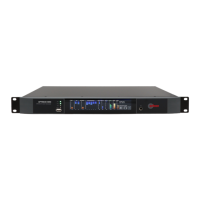2-10 Installation
x The electronically balanced input uses an ultra-low noise and distortion differential amplifier for best common
mode rejection and is compatible with most professional and semi-professional audio equipment, balanced or
unbalanced, having a source impedance of 600: or less. The input is EMI suppressed.
x Input connections are the same whether the driving source is balanced or unbalanced.
x Connect the red (or white) wire to the pin on the XLR-type connector (#2 or #3) that is considered HIGH by the
standards of your organization. Connect the black wire to the pin on the XLR-type connector (#3 or #2) that is
considered LOW by the standards of your organization.
x In low RF fields (like a studio site not co-located with an RF transmitter), connect the cable shield at 6300 input
only—it should not be connected at the source end. In high RF fields (like a transmitter site), also connect the
shield to pin 1 of the male XLR-type connector at the 5950 input.
x If the output of the driving unit is unbalanced and does not have separate CHASSIS GROUND and (–) (or LOW)
output terminals, connect both the shield and the black wire to the common (–) or ground terminal of the
driving unit.
Analog Audio Output
x Electronically balanced and floating outputs simulate a true transformer output. The source impedance is
50:. The output is capable of driving loads of 600: or higher; the 100% modulation level is adjustable with
the AO 100% control over a –6dBu to +24dBu range.
x If an unbalanced output is required (to drive unbalanced inputs of other equipment), it should be taken
between pin 2 and pin 3 of the XLR-type connector.
Connect the LOW pin of the XLR-type connector (#3 or #2, depending on your organization’s standards) to
ground; take the HIGH output from the remaining pin. No special precautions are required even though one
side of the output is grounded.
x Use two-conductor foil-shielded cable (Belden 8451, or equivalent).
x At the 5950’s output (and at the output of other equipment in the system), do not connect the cable’s shield
to the CHASSIS GROUND terminal (pin 1) on the XLR-type connector. Instead, connect the shield to the chassis
ground at the input destination. Connect the red (or white) wire to the pin on the XLR-type connector (#2 or
#3) that is considered HIGH by the standards of your organization. Connect the black wire to the pin on the
XLR-type connector (#3 or #2) that is considered LOW by the standards of your organization.
AES3 Digital Input/Output
There are two AES3 and two AES3 outputs.
x Digital 1 input accepts a standard AES signal and can operate at 32, 44.1, 48, 88.2 and 96 kHz.

